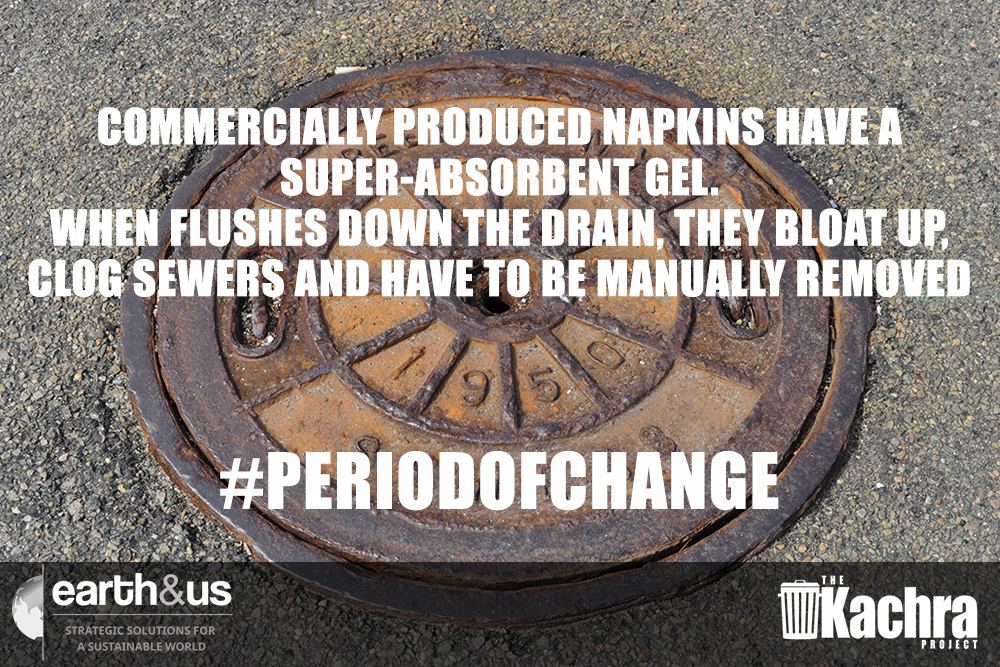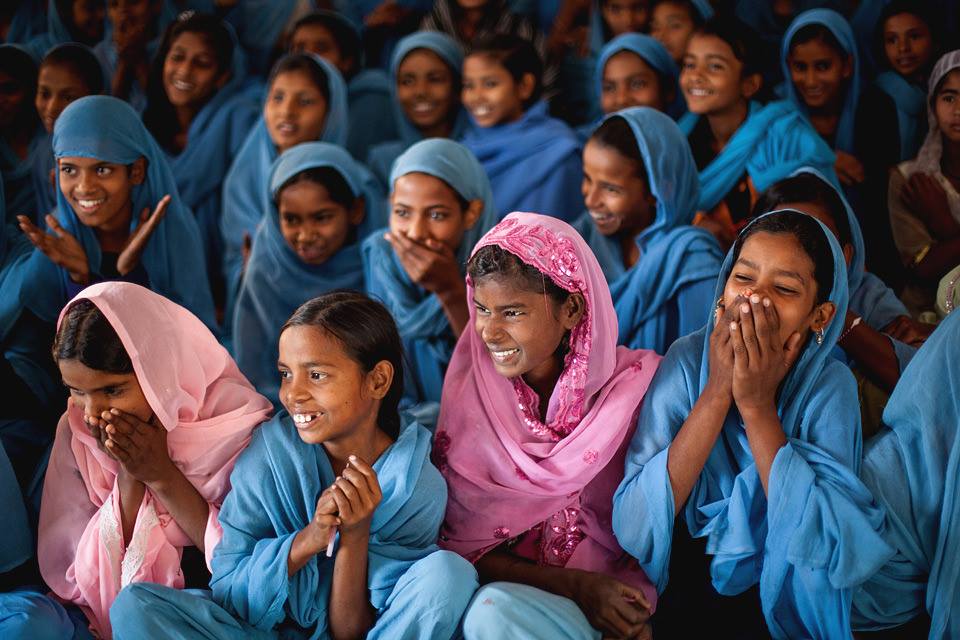Best Practices for Menstrual Waste? Here’s What Many Indians Don’t Know About Sanitation, but Should!
In recent years, awareness of waste sanitation in India has heightened thanks to organisations such as Eco Femme and individuals including Arunachalam Muruganantham aka India's 'Menstrual Man.'

As a woman from the UK, waste sanitation is not an issue that I’ve ever really had to think about, lest worry about.
In the UK, sanitary waste disposal is governed by legislation, this ensures proper disposal of sanitary waste. The Workplace (Health, Safety & Welfare) Regulation 1992 recommends that all businesses should ensure that female toilets are provided with a suitable method for sanitary disposal. Special bins are provided in public loos for hygienic disposal and these bins are emptied regularly.
However, as a woman living in India, disposing sanitary waste is something I often have to think about, sometimes even worry about. And such is the monthly plight of countless Indian women across the country.

The disposal of sanitary waste in India is a complex issue. The fact that it remains a largely taboo topic and carries much social stigma only adds to its complexity and makes it difficult to find effective solutions. Which is unacceptable when you consider just how much of India’s population the issue directly affects, let alone the amount indirectly affected by improper menstrual disposal on top of this.
In collaboration with Aakar Innovations, The Better India is setting up a sanitary pad manufacturing unit in Ajmer, Rajasthan, that will not only produce eco-friendly or biodegradable sanitary pads, but will also employ women from rural communities around the area.
Contribute for the campaign here.
Unable to view the above button? Click here
Taboo and social stigma is hindering the country’s progress.
India’s discomfort with discussing menstruation openly dictates how women dispose of their sanitary waste. The Water Supply and Sanitation Collaborative Council (WSSCC) reports that every month, more than 350 million women and girls in India feel ashamed, uncomfortable and often unsafe as they try to manage their periods while also trying to hide the fact from everyone.
This sense of shame means that not only are many left to deal with the issue alone, feeling unable to voice their challenges, but also that the facilities where one can dispose of sanitary waste safely are at best ineffective, at worst harmful and dangerous, and much of the time, non-existent.
According to a report cited in the Clean India Journal, an estimated potential of 9000 tonnes of sanitary waste (432 million pads) is being generated annually in India.
Furthermore, more than 80 per cent of this waste is either flushed down the toilet or ending up dumped in a landfill.

India is evidently facing a serious crisis. Sanitary waste disposal is not merely a waste management issue, it’s a health and human rights issue that affects the entire country. As there is currently no standardised method of sustainable sanitary waste disposal, every menstrual product disposed contributes to either soil, air or water contamination.
Any soiled sanitary products is a breeding ground for infections and diseases. Stagnant menstrual blood accumulates bacteria such as Escherichia coli, or E coli, which multiplies at an alarming rate. Furthermore, a report by AC Nielsen found that only 12% of India’s 355 million menstruating women use sanitary napkins and 88% of women resort to shocking alternatives like unsanitized cloth or rags, ashes, newspaper and husk sand. Not only are these practices highly unhygienic, they pose a high-risk to the health of women through various infections and diseases.
In collaboration with Aakar Innovations, The Better India is setting up a sanitary pad manufacturing unit in Ajmer, Rajasthan, that will not only produce eco-friendly or biodegradable sanitary pads, but will also employ women from rural communities around the area.
Contribute for the campaign here.
Unable to view the above button? Click here
Cultural and social influences remain major barriers as menstruation is still considered impure in many parts of India. Lack of education and awareness among people, unwilling to accept otherwise, still leads to restrictions on women’s lives during their menstruation. A report by The Water Supply and Sanitation Collaborative Council (WSSCC) stated that of 478 girls in Rohtak, Haryana, 75% were forbidden from worship, 45% were not allowed in the kitchen and nearly a quarter had dietary restrictions during their periods.
It is becoming clear that a multi-layered and multi-sectoral approach to combat the issue is the need of the hour.
In 2014, during the Independence Day commemoration, PM Narendra Modi asked during his speech, “Has it ever pained us that our mothers and sisters have to defecate in the open?” The question forced the issue of sanitation on to the nation’s agenda and brought about an increased awareness of the critical situation.
Shortly before this, Arunachalam Muruganantham, aka India’s menstrual man made global news with his development of an easy-to-use machine for producing low-cost sanitary pads.

Over the past few years, several attempts—including a variety of methods and campaigns—have been made to tackle the issue of waste sanitation.
Last month, the youth-led organisation SheSays launched an online campaign with the hashtag #LahuKaLagaan, meaning ‘tax on blood,’ in an attempt to put an end to India’s tax on sanitary pads. The campaign stated that the tax on sanitary napkins is on average 14 percent under the Goods and Services Tax system. It is believed that the high costs of sanitary pads prevents much of India’s women population from being able to afford such products, thus forcing them to seek alternative options.
Whilst making commercial pads more affordable may put a stop to women using more harmful, less-hygienic alternatives, the move is likely to be an environmental disaster for the environment. Firstly, they are disposable and must be discarded after one wear. Most commercial brands have a significant component of non-biodegradable plastic, so an increase in users means an increase in waste. Where will it end up?
In India, disposable sanitary napkins, like in most parts of the world, are either flushed down the toilet, thrown into the trash or burnt.
All these methods lead to adverse impact on the environment and people.

The Indian government’s interim solution to the problem is incineration. According World Health Organisation (WHO) recommends that incineration of sanitary waste be done at temperatures above 800 degrees. In India however, most incineration is done in low-temperature incinerators as not only is it difficult to handle such high temperature, there is also no provision for monitoring emissions. Burning sanitary pads release harmful toxins, posing serious health risks for those in proximity. Without proper precautions, this method not only leads to pollution but can also pose serious health issues.
Thus it would suggest that cost-effective, waste-free options are the most viable solution to India’s waste sanitation issue.

Eco Femme, a women-led social enterprise based in Tamil Nadu, manufactures washable cloth pads as an alternative to disposable pads. Founder Kathy explains, “Essentially a single cloth washable pad (that lasts 75 washes) is equivalent to 75 single use and throw disposable sanitary napkins. Cloth pads prevent significant amounts of waste. Made from natural materials, they are healthier when cared for properly and they save money as well.”
For an environmental perspective, re-usable cloth is a great alternative to disposable pads. However, proper care is required to ensure that they remain fit for purpose. For example, Eco Femme states that they should be washed in a machine at a maximum of 40 degrees celsius. Many women in rural India lack access to clean water, so this is not a viable solution for such women. General recommendation say handwash works, but drying in proper sunlight is crucial. Taboos means that women hesitate to put their pads out in the sun.
Another reusable menstrual product is the menstrual cup, a reusable, bell-shaped cup that is worn internally. Although menstrual cups have a high upfront cost – ₹300-1000 INR compared to ₹30-60 for disposable sanitary products such as pads – they last for 10 years and after two years become the more cost effective option. An added advantage of the menstrual cup is that it requires very little water to keep it clean which is an advantage for those women in rural areas. The biggest challenge with this option however, is getting women to feel comfortable trying it out.
You many also like: MY STORY: How Using Menstrual Cups Gave Me Period Peace
The education and empowerment of women is key.

No doubt the first and foremost strategy in tackling India’s sanitary waste issue is raising awareness among adolescent girls related to menstrual health and hygiene. Young girls often grow up with limited knowledge of menstruation and adults can shy away from discussing the issues with them. Mothers and adult women may themselves not be aware of the biology of periods or hygienic practices and instead often pass on cultural taboos and restrictions.
Empowering women through education, and increasing their role in decision-making, can aid in this regard. The responsibility does not lie solely on women to fix the problem, but their voices must be heard and their experiences given weight in this matter.
Break the bloody taboo is an initiative by Sacchi Saheli, an NGO that works to bring menstrual awareness into schools. They bring ‘period talks’ to government schools and other institutions to educate girls about menstruation and help to normalise the process. The project also works with families to dispel taboos and tackle any myths surrounding the issue. Furthermore, the classes help girls understand other taboo issues such as sexual abuse.
In collaboration with Aakar Innovations, The Better India is setting up a sanitary pad manufacturing unit in Ajmer, Rajasthan, that will not only produce eco-friendly or biodegradable sanitary pads, but will also employ women from rural communities around the area.
Contribute for the campaign here.
Unable to view the above button? Click here
When it comes to sanitary waste, although there is no single solution to the issue, there are methods and practices that are working and need to be made a priority.
India can no longer hide its responsibility of devising a solution to its sanitary waste issue in the dark, like women across the country are forced to do with their menstrual pads. Awareness must continue to rise so that society is forced to take an active stance. There is simply no excuse for ignorance on the issue, action must be taken. Period.
Know more about Eco Femme here.
Like this story? Or have something to share? Write to us: [email protected], or connect with us on Facebook and Twitter.
NEW: Click here to get positive news on WhatsApp!
If you found our stories insightful, informative, or even just enjoyable, we invite you to consider making a voluntary payment to support the work we do at The Better India. Your contribution helps us continue producing quality content that educates, inspires, and drives positive change.
Choose one of the payment options below for your contribution-
By paying for the stories you value, you directly contribute to sustaining our efforts focused on making a difference in the world. Together, let’s ensure that impactful stories continue to be told and shared, enriching lives and communities alike.
Thank you for your support. Here are some frequently asked questions you might find helpful to know why you are contributing?


This story made me
-
97
-
121
-
89
-
167











